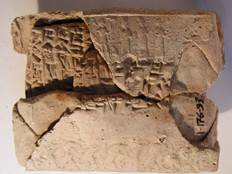This is an old revision of the document!
Table of Contents
Old assyrian letters
Introduction
During the Old Assyrian period (first three centuries of the 2nd millennium BC), Aššur was an independent city-state dominated by an oligarchy of merchants. At the end of 20th and beginning of 19th century BC, the Assyrian merchants developed long-scale trade to central Anatolia, settled there and organized trading outposts, most prominent of which was Kaneš, modern Kültepe (Turkey). Most of the 22,500 Old Assyrian tablets were found in the houses of merchants located in the lower town; they belong to the private archives, mainly of Assyrian merchants, and contain letters, legal texts and private notices.
Overview of corpus
Letters are usually the most numerous and form between 30 to 40% of an Old Assyrian archive. Almost 1000 Old Assyrian texts are classified as letters in the CDLI, making Old Assyrian one of the largest corpora of letters from Ancient Mesopotamia.
Format
Old Assyrian letters start by the classical Mesopotamian address style: ana NP1 qibī-ma umma NP2-ma. But when the sender had a higher status than the recipient, the order was reversed. There could be several senders and/or several recipients. There is no blessing formula at the end of the letter.
A short exhortation can be found any place within the letter (abī atta, "You are my father!", often together with bēlī atta, "You are my lord!", ahī atta, "You are my brother!" etc.).
There was no standard size or shape for letters. Some were extremely short, written over less than five lines, others needed an additional tablet called ṣibat ṭuppim.
|
|
Letters were covered by clay envelopes which bear the identity of the correspondents as well as the seal impression of the sender. Letters in their envelopes were travelling wrapped in textiles and leather, on donkey caravans or by special messenger.
Contents
Letters form the correspondence exchanged between the Assyrian merchants in Kaneš, their families and colleagues in Aššur or settled in other Assyrian trading outposts located in Central Anatolia.They relate to commercial exchanges, but also tackle domestic matters and daily life, especially women’s correspondence. Some letters were sent by the ruler of Assur ("the foreman, or steward", wa-ak-lum2), "the trading post" (ka3-ru-um, Kaneš), or a specific trading post (ka3-ri-im GN)
A few letters exists that can be described as diplomatic correspondence involving the Assyrian authorities and local Anatolian rulers (LAPO 19 91 = RA 60, 120, LAPO 19 93 = Kt 85/k 27), or only Anatolian rulers (Example: LAPO 19 62 = Kt g/t 35).
Letters are never dated.
The letter is referred to by the words ṭuppum “tablet” or našpertum “message.”
The recipient kept in his archives the letters he received for personal reasons or for the data they contained, as a reminder of his commercial activities, of orders given to colleagues or representatives, etc. One could also keep in his archive copies of the letters he sent.
Sample Text
CCT 3, 20:
Bibliography
C. Michel, 2001. Correspondance des marchands de Kaneš au début du IIe millénaire av. J.-C., Littératures du Proche-Orient ancien 19, Paris : Editions du Cerf.
C. Michel, 2008. La correspondance des marchands assyriens du xixe s. av. J.-C.: de l’archivage des lettres commerciales et privies. Pp. 117-140 in La lettre d’archive. Communication administrative et personnelle dans l’Antiquité proche-orientale et égyptienne, ed. Laure Pantalacci. Topoi Suppl. 9. Le Caire: IFAO. http://halshs.archives-ouvertes.fr/halshs-00644198/fr/
C. Michel, 2015. Les lettres des rois d’Aššur découvertes à Kaniš (xixe siècle av. J.-C.), in S. Procházka, L. Reinfandt & S. Tost (ed.), Official Epistolography and the Language(s) of Power. Proceedings of the First International Conference of the Research Network Imperium & Officium. Comparative Studies in Ancient Bureaucracy and Officialdom. University of Vienna, 10-12 November 2010, Papyrologica Vindobonensia 8, Vienna: Verlag der Österreichischen Akademie der Wissenschaften, p. 43-60.
K. R. Veenhof, 2008. Communication in the Old Assyrian Trading Society by Caravans, Travelers and Messengers, in C. Michel (éd.), Old Assyrian Studies in Memory of Paul Garelli, OAAS 4, PIHANS 112, Leyde. Pp. 199–246.
Cécile Michel


